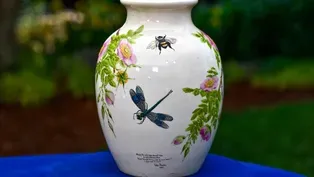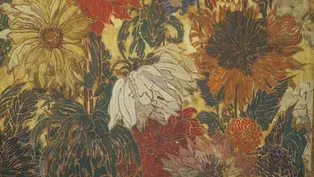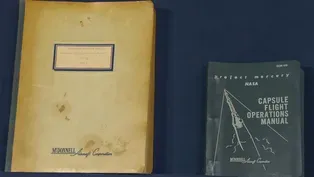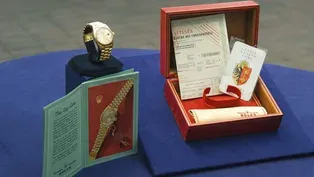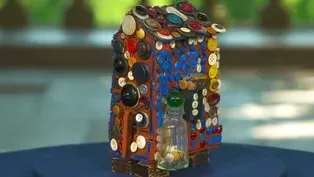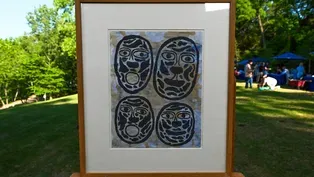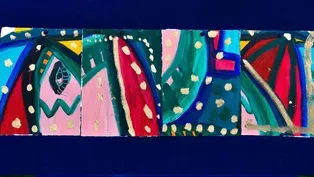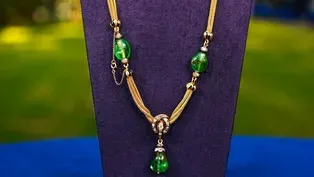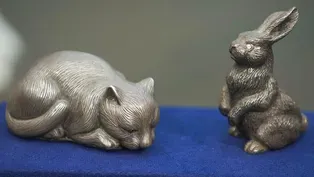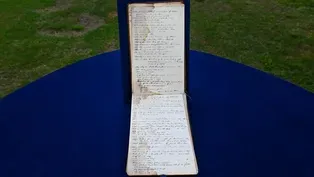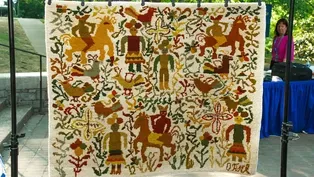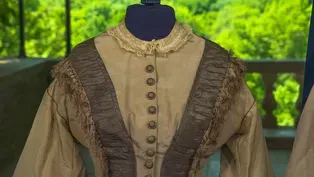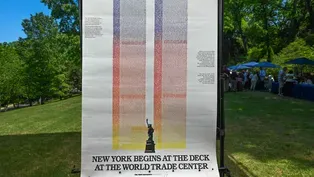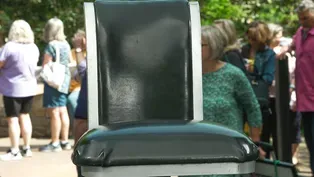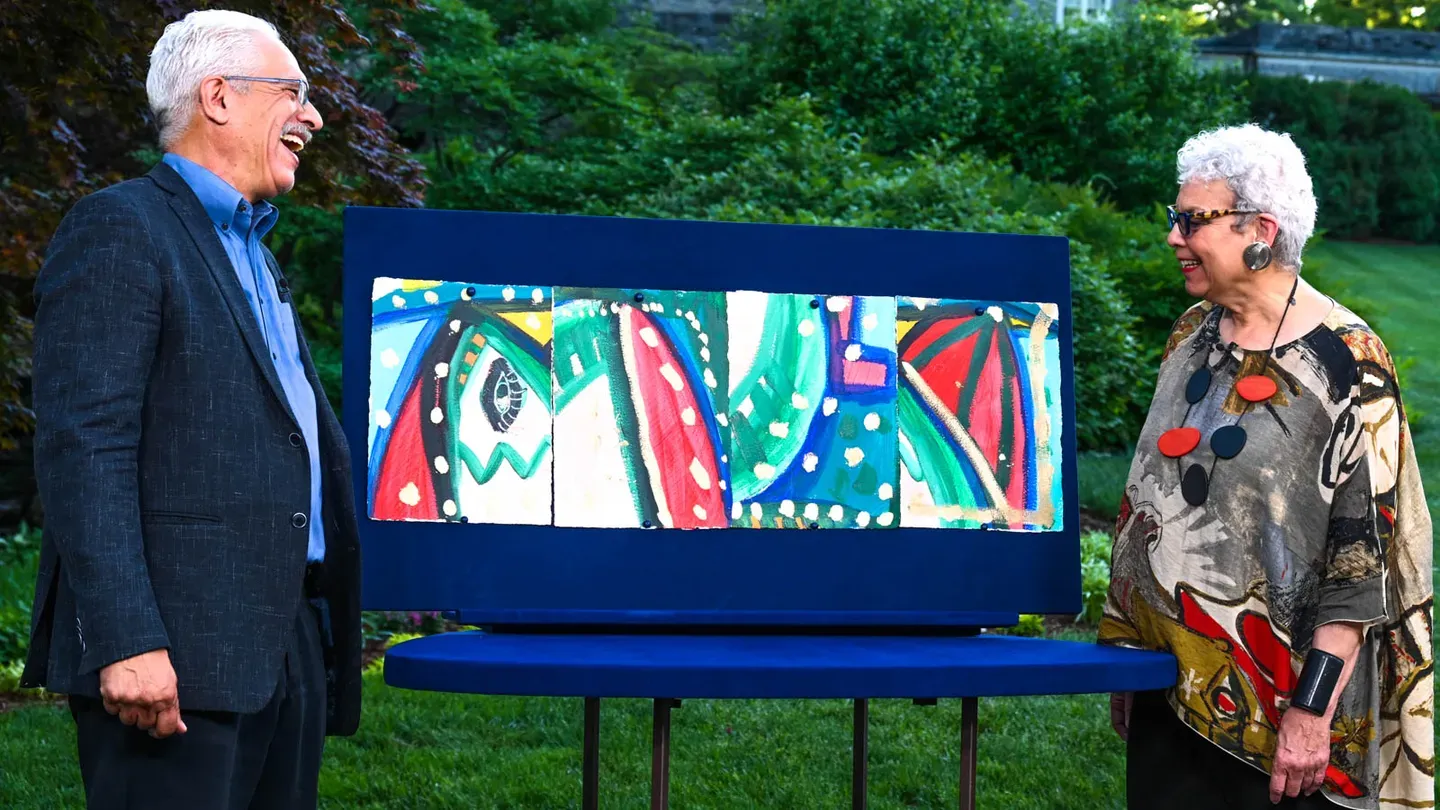

Cheekwood Estate & Gardens, Hour 1
Season 27 Episode 7 | 52m 27sVideo has Closed Captions
Watch charming appraisals at Cheekwood Estate & Gardens, like one valued at up to $80,000!
Watch charming appraisals from Cheekwood Estate & Gardens including an 1880 Celia Thaxter hand-painted vase, a 1964 Presidential Rolex with the box and papers, and a Mary Elizabeth Price painted screen, ca. 1925. Guess the top find!
Problems with Closed Captions? Closed Captioning Feedback
Problems with Closed Captions? Closed Captioning Feedback
Funding for ANTIQUES ROADSHOW is provided by Ancestry and American Cruise Lines. Additional funding is provided by public television viewers.

Cheekwood Estate & Gardens, Hour 1
Season 27 Episode 7 | 52m 27sVideo has Closed Captions
Watch charming appraisals from Cheekwood Estate & Gardens including an 1880 Celia Thaxter hand-painted vase, a 1964 Presidential Rolex with the box and papers, and a Mary Elizabeth Price painted screen, ca. 1925. Guess the top find!
Problems with Closed Captions? Closed Captioning Feedback
How to Watch Antiques Roadshow
Antiques Roadshow is available to stream on pbs.org and the free PBS App, available on iPhone, Apple TV, Android TV, Android smartphones, Amazon Fire TV, Amazon Fire Tablet, Roku, Samsung Smart TV, and Vizio.
Buy Now

ANTIQUES ROADSHOW 2025 Tour!
Enter now for a chance to win free tickets to ANTIQUES ROADSHOW's 2025 Tour! Plus, see which cities we're headed to!Providing Support for PBS.org
Learn Moreabout PBS online sponsorshipCORAL PEÑA: "Antiques Roadshow" has landed in Nashville, the Music City, for an unforgettable stop at Cheekwood Estate and Gardens.
"I'll tell you what, let me buy you lunch," and he gave me the poster.
My granddaughter wanted to make mud pies in it.
Sounds fun to me.
(laughs) ♪ ♪ PEÑA: Cheekwood is a Nashville treasure.
"Cheekwood" is a combination of its original owners' names, Leslie Cheek, Sr., and Mabel Wood Cheek.
And would you believe that America's love of coffee helped make it possible?
Their family fortunes grew after investing in Leslie's cousin's company, Maxwell House Coffee, which sold in 1928 for over $40 million.
That's a lot of java.
All aspects of the landscape, architectural, and interior designs were in the trusted hands of Bryant Fleming, who created an overarching country estate masterpiece.
"Roadshow" is always on the hunt for undiscovered masterpieces.
What will we see today?
It says "good luck" on it, so I hope that it's good luck.
Yes!
APPRAISER: This is a really colorful, interesting vase.
Tell me about it.
Sunday, which was Mothers' Day, my daughter gave it to me, and it came from her husband's grandmother's grandmother.
Okay.
And came down through the family.
That's all I know; I don't know anything else about it.
And so what did your family think about it?
My granddaughter wanted to make mud pies in it, but... Oh, well, sounds fun to me.
(laughs) Do you like it?
Were you happy with it?
No, it's ugly.
It's ugly, okay.
It's ugly, yes.
Why, why do you say that?
It looks cheap.
That's a perfectly fair thing to say.
(laughs) The vase itself is pottery.
This, quite frankly, is a very poor-quality pottery vase.
But it's very well-painted.
It's very colorful.
Yes.
And it's hand-painted.
And it's got these wild roses on it, thorny branches, butterflies.
And then we've got this wonderful bumblebee... Mm.
...and a dragonfly.
And then right here, we have a few lines of poetry and a woman's name: "Celia Thaxter, 1880."
The lines of the poem read: "O cup of the wild rose "curved close to hold odorous dew, "What thought do you hide in your heart?
O, would that I knew!"
Celia Thaxter was born in 1835 in New Hampshire.
Oh, wow.
Uh, when she was 16 years old, she married her tutor, who was 11 years older than her, Mr. Levi Thaxter, and she had three children.
And she had, was somewhat educated.
She came from a, a nice family... Mm-hmm.
...in New England, and she lived in Massachusetts with her husband.
And she became a very well-known and respected American poet.
Wow.
Many books of her poetry were published.
She knew lots of famous people.
She knew Emerson, she knew Thoreau, she knew Longfellow, and so she was really an important poet in her own time.
Wow, that's good.
She lived mostly remotely, in Maine, on islands, and her father had a hotel named Appledore House.
And she lived there most of her life, a, away from her husband.
She wrote lots of poetry about the sea.
She loved nature and flowers.
But another thing she's known for is painting on pottery and porcelain.
Mm-hmm.
And she always did floral subjects.
She is known as being part of the early Arts and Crafts movement in America.
Now, it's really hard to value this.
I, I, I could find some auction records for some of her hand-painted pieces.
Mm.
But this far exceeds the quality of any of the others, and none of the others have this poetry.
I think a retail price would probably be somewhere in the $3,000 to $5,000 range.
It's not so ugly anymore.
Mm-hmm, yeah, well, you know... (laughs) You still don't have to like it.
It can grow on you.
(both laugh) It could bring more than that.
Wow.
I never would've thought.
Who would've thought?
This ugly vase.
WOMAN: This is a piece originally owned by my grandmother, made by Beverly Buchanan.
Beverly Buchanan is from South Carolina, I believe, but spent most of her working career in Georgia after being educated in New York.
What she's known most for is her shacks, both the, these kind of sculpture, mixed-media pieces and paintings.
She was inspired by rural, particularly African American, Georgia residents and their shotgun-style, like, homemade homesteads like this.
So how did this come to be in your family?
My grandmother was Beverly's CPA, and became her friend over that relationship, and she collected a lot of her art throughout their friendship, both being gifted it and purchasing it.
So, I don't know which one she did for this particular piece.
She was born in North Carolina, and then went to graduate school at Columbia University in New York, and then, in 1971, decided to go study art with Norman Lewis, who was a very well-known African American painter who was an Abstract Expressionist.
And he and a group of other painters had a gallery called the Cinque Gallery.
And she was mentored by another member of that group, Romare Bearden, who was a very famous collagist.
She showed her work at that gallery, among some other galleries in New York, before returning to the South in the late '70s.
So what I like about this piece is that while it's representational of a house, it also does have abstract elements to it, and it has, obviously, a collage element to it.
It's signed and dated on the bottom, 1996.
Ah.
She moved back, uh, to Georgia in the 1970s and began making pieces like this for the next 20, 25 years.
This piece was part of her "Shacks" series, where she did a series of paintings and constructions like this that reflected the architecture and the life that she knew in Georgia.
The house is made of a wooden base that's been painted blue and a sort of a brownish red, and that's very typical of most of the shacks that I've seen.
But this one's particularly nice, because it's got all of the different buttons on it, and also has the salt shaker, a domestic item, and has these little sequins on the door.
And on the side, it has the spool of thread attached to the house, used as a basket.
There's just a lot-- a great deal of variety in the pieces that she chose to use.
There's been a lot of, uh, interest in her work at auction lately.
The last couple of pieces like this that have come up at auction have done very well.
This one is, uh, particularly nice.
I think it's better than the last two.
And there was a fierce bidding over the last couple of pieces.
So, if this were to go to auction, I believe that the estimate would be $10,000 to $15,000.
Rea... Wow!
Okay!
(smacks lips) (laughing): Wow, thank you.
I wouldn't be surprised if it did better than that at auction.
Oh!
(chuckles) So, it's a really beautiful piece, and...
Thank you, I love it, too.
Somebody I know just had it in their attic.
And I was, like, "Can I take your train set?"
And he said, "What?
I don't have a train set."
I was, like, "Oh, you do."
You absolutely have a train set.
And so, like, there's this wonderful, beautiful, unused train set apparently he didn't know existed.
MAN: Yeah, do you think you'll play with it?
I absolutely will, I can't wait.
I can't wait, I'm going to go back to the hotel.
(laughing): I'm going to definitely play with the train set.
♪ ♪ My wife found this at a garage sale.
Um, the guy said he'd had it for 40 years.
And we know it's a rocker, and we think it's Herman Miller, but we don't know much more about it than that.
When I get a little older, I'm sure I'll rock in it more often.
(laughing) ♪ ♪ I moved to Nashville in 1988, and Woolworth's department store was closing all of, their stores locally, and they had a sale of fixtures.
So I decided to try to see if they still had the lunch counter stools.
So when I went downtown to check it out, they, they had 14 of the stools still left, but he had taken the tops of the stools off, so he just had the post and the floor.
So I inquired about, if, if they were still available, if they had 'em.
He said, "I do have them.
I, I have the stools' seats off in the basement."
And then he said, "If you can get 'em all out of here, you can have 'em for $50."
So I paid $50 for all 14 of the stools.
Wow.
I knew that, that this was very possibly part of the sit-in, so I, uh, inquired with the museum, Tennessee State Museum, about these stools, and they did some research, and confirmed that they were part of the sit-in, even though it wasn't the original Woolworth's, it was W.T.
Grant's at the time in the city in 1960.
You have how many now?
I have four still.
Okay, and the other ten?
I, uh, sold to the museum, the Tennessee State Museum.
Okay, so when did you do that?
Early 1990.
The ten stools I sold to the museum, I sold them for $300.
So you six-timed your money... (chuckles): Yes, yes.
...just on those ten.
So you have an iconic piece of American history that represents the civil rights struggle, represents an ongoing struggle.
Did you know that the sit-ins ended on May the tenth, 1960?
I, I knew they, they ran several weeks, but I didn't realize it was that long.
What is today?
Oh, today is m, yes.
62nd anniversary of the end of the sit-ins.
Wow.
Mm-hmm.
And the student organizations and the civil rights organizations that participated in this... Mm-hmm.
There were students there from Fisk University and other places.
And one of the people that emerged as a leader in that was John Lewis.
Mm-hmm, yes.
What John Lewis and those students did was a nonviolent protest.
And by May 10, they had negotiated with the mayor that six downtown places would serve Black people and it wouldn't be segregated seating.
Wow.
That nonviolent protest became the model for a lot of things that came after that.
Wow, that's...
So... How do you put a value on something like that?
Correct, yes.
What do you think they're worth?
I mean, in, in the past, I was estimating maybe $1,000 apiece, maybe, of the four, so maybe $4,000?
I talked to, uh, one of my colleagues here whose company has sales that specialize in African American history and art.
He said that if they had, like, a bathroom sign or something from the '50s... Mm-hmm.
...that said "colored only," that things like that would bring $3,000 to $5,000 and up.
Wow.
Small signs that say, "I'm a man."
That's at least $5,000 and up.
Wow.
So it's not a scientific process, but we felt like each of the stools would be worth at least $3,000 to $5,000.
Wow.
I'm glad I saved 'em.
You and me both.
PEÑA: To furnish Cheekwood, Leslie and Mabel Cheek went on a months-long shopping trip to Europe, where they bought architectural pieces from 18th-century Georgian homes, tapestries, furniture, and more.
Today at the mansion, there are a mix of pieces acquired after the house became a museum and pieces once owned by the Cheeks, like this English rococo gilt wood mirror from around 1760 that was donated back to Cheekwood by daughter Huldah Cheek Sharp.
MAN: I see, so we're going to pick that up at one point.
Yup, and we're going to do it live and then we'll go back.
Okay.
Perfect, no problem at all.
This is a Art Deco silver plate set that I purchased in San Francisco.
Uh, elderly neighbor of ours decided to move into a retirement home, so she called my husband and I and said she was selling her wares.
My husband went, and it was in cardboard box wrapped in cellophane with rubber bands on it that were so rotted they were falling off, and it was pitch-black.
So he asked her, uh, how much he, she wanted for that, and she said $25.
So you paid $25 in what year?
It was 1985, '86, somewhere around there.
We've had it on display at, at the house.
It's really sort of a, uh, pain to keep clean and polished.
(laughs) So it's spent the last year or so in the closet.
This is an Art Deco tea and coffee service.
We have a coffee pot, teapot, covered, double-handled sugar bowl, and a cream pitcher on a matching tray.
This is silver-plated nickel, and overall, it's got that bright, shiny silver finish we expect.
But the handles are this blackened, darker finish to the metal.
This is an iconic example of Jazz Age design influenced by the architecture, music, and culture of the time.
This was designed and debuted around 1925 to 1928.
This set dates probably from right around 1928.
This is called the Skyscraper... Mm-hmm.
...Tea and Coffee Service.
The mark reads, "Skyscraper, patent pending, Apollo EPNS," which, that's our American indication of silver plate.
Okay.
And then, "Made in the U.S.A. by Bernard Rice's Sons, Inc." Bernard Rice's Son, Inc., is a firm that actually had its beginning in the late 19th century.
It formed from two brothers who each had their own silver companies.
Mm-hmm.
And they combined in around 1897.
Then 1904, they merge with a third firm, called Apollo, and become Bernard Rice's and Sons.
And one of the family members, Louis Rice, assumes the presidency of this new combined firm in 1917.
And it is he who designed this whole line of Skyscraper tablewares, and it was wildly popular at the time and remains so through to today.
So much so that single pieces of Skyscraper Tableware are in museum collection and exhibited as stand-alone examples of important early 20th century design.
Very few have ever appeared on the market as complete as this.
One thing to note is that it does have a K monogram.
Can you tell us the background behind that?
Yes, the owner lived in New York.
He worked for Bechtel Corporation, an engineering firm, and he was transferred to San Francisco from New York.
He was going to be helping with the construction of the Golden Gate Bridge.
And he was given this gift as a parting gift from either his coworkers or the company.
And so the designer put their initial on it.
If this were to go to auction, I believe they would put a conservative auction estimate of $15,000 to $25,000 on it.
(chuckles) Wow.
(chortles) Wow, um...
It's amazing, thank you.
(chuckles) Wow, I can't wait to tell everybody.
So... (chuckles) (stammers) Makes me a bit... (stammers): Choked up, so... Conservative insurance value would be $40,000.
Oh, God!
(laughs) They were painted by an old friend of mine named Frederick J.
Brown.
I met Fred in college, and it was in the late '60s.
And most Black people were wearing Afros and dashikis.
Uh-huh, there we go.
And Frederick wore suits and ties.
So he was different in that sense.
Yes, he was, and he always considered himself an artist, and he always felt that he'd be a famous artist one day.
He invited me by his apartment.
(laughs): And he opened the door, and he had on a smoking jacket and an ascot.
(laughing) And I was doing all I could to get my hair to stand all over my head and wear something, uh, Afrocentric.
(laughs): Yeah, yeah.
And he was, uh, Mr. Sophisticated.
He was like a gentleman.
Mr. Sophisticated.
When he dressed up, he was dressed.
What school did you go to, that all of this happened?
Oh, I graduated from Southern Illinois University in Carbondale, Illinois.
And that's where he was going, as well?
Yes.
So did you guys take any classes together?
No, he was an art major at the time.
Okay.
Art or architecture, I'm not quite sure.
Okay.
But I was, uh, an elementary education major.
Uh-huh.
But we just knew each other, and we maintained this friendship, uh, until he, he passed.
I went to see him a few months before, uh, he passed.
He passed in 2012.
I think I got them in 2011.
I don't know the occasion.
Do...
He said, "I've got some...
I've got some art I've got to send you."
And I said, "Okay."
(chuckles) And he did.
And what do you know about the pieces themselves?
There are four pieces in this series, and he's entitled them "Going Home."
Um, I'm not sure what that means, but I like them.
(chuckles): Right.
So as you say, Frederick Brown, he was actually born in 1945 in Georgia, and he grew up in Chicago.
He ends up in New York, and finally between New York and Scottsdale, Arizona.
He's an African American artist.
And especially now, just in general, African American art is really taking off.
He is known as an Abstract Expressionist painter, but he also has done portraits that are kind of stylized, and was a big fan of jazz music, so that also informs his work quite a bit, but these are quite lovely pieces.
If you look at the back, he's inscribed them to you.
He's put the title, "Going Home."
And notice here, he's got a one over four.
So this is the first of four images.
He's signed it here, uh, "F. Brown," and he's dated it 2010.
But look at here, he's in, indicating how he wants them displayed, as we've displayed them here.
He wants 1,2,3,4 horizontally arranged.
So what we have here is a quadriptych.
In other words, a four-panel work of art.
And they're mixed media on paper.
It's mostly acrylic, but it looks like a little watercolor mixed in there.
His work is in the collection of the Metropolitan Museum and some very prestigious museums.
And so he's acknowledged in the art world as an established and accomplished artist.
His portraits, I think, uh, are more popular and more, he's more known for.
But these pieces also are, are sought after.
For these four pieces, as a complete set, retail value would be $20,000.
That sounds good.
(both laugh) That's very good.
Yeah, thank you.
Well, my oldest son started playing fiddle when he was four.
And so we went to a fiddle workshop in Illinois at Lincoln's New Salem.
And, uh, during the lunch break, the lady came out and said, "I have an extra fiddle in the car if you guys would like to try it," so... And then she said she was thinking about selling it.
So she shot us a price, and my husband went home and sold his truck and bought me this fiddle.
MAN: I got to ask, how much did you have to sell the truck for to get that?
$400, even money.
♪ ♪ WOMAN: My father, Charles Anderson, was in the United States Air Force, 1953 to 1957.
APPRAISER: Mm-hmm.
He was a fighter pilot.
And after he did his service, he got a job at McDonnell Aircraft Corporation in St. Louis, Missouri.
Mm-hmm.
And he was a technical writer.
In 1959, they assigned him to Project Mercury... Mm-hmm.
...to write the astronaut handbook.
Mm-hmm.
So that's the, uh, smaller manual, and that is the size of the manual that was taken into space with the Mercury astronauts.
He gifted the manual to us in 2018.
And at that time, he mentioned he might have a couple other copies of the manual in the attic.
So he came down from the attic.
This was the first edition of the manual.
Mm-hmm.
And then the one on the other side of the table is the final signed proof copy, where everyone had to sign off on the manual before it was printed.
So, 1961, that was the height of the space race, trying to put the first human into outer space.
The Mercury Project was a culmination of all of our efforts.
That was the name of the space capsule that one of the seven Mercury astronauts was going to use to be the first American to outer space.
Because in April of 1961, the Soviet Union had just got Yuri Gagarin into space.
And this project was a little bit rushed.
The capsule was very, very small.
It could barely fit one person.
So they consolidated all this information into a little 104-page manual.
And that's not a whole lot of pages.
This actually has less information than your car's manual nowadays.
And what's fascinating is, who signed it?
Alan Shepard.
And did your dad tell you ever about meeting Alan Shepard?
I was with my father when Alan Shepard autographed his copy of the manual.
Mm-hmm.
In 1990, Alan Shepard was autographing some books down in Huntsville, Alabama, at the s, rocket museum.
Mm-hmm.
And as they were going through the line, my dad put this in front of Alan Shepard.
And he paused and he looked up, and he goes, "I haven't seen one of these in 40 years."
And he goes, "Where did you get this?"
Mm-hmm.
And my father said, "I wrote it."
Mm-hmm.
And he stood up and shook my father's hand and nice little chit-chat for a couple of minutes.
Mm-hmm.
And autographed it for him.
His autograph is out there, but having it on something that is so important to his survival is really, really impressive.
These things are so rare.
After consulting with my colleagues, we feel that we'd give an insurance value of $8,000 to $10,000 for these three books.
My father would be proud.
♪ ♪ PEÑA: Lining the Transverse Hallway are paintings on canvas that were done with the trompe-l'oeil technique, realistic, seemingly three-dimensional images that are meant to fool the eye.
The panels portray the arts, such as music, drama, painting, and sculpture, and also the four seasons.
The Cheeks purchased the original panels in 1929 from a London dealer, and had complementary murals painted to complete the set.
MAN: In 1986-87, my wife and I lived in the Bronx, and this poster was in the bus stop.
One day, I was going in late to work.
A guy was out there changing the posters, and I, I went over and kindly asked him, I said, "Listen, what do you do with the posters?"
And he said, "Well, uh, we just take 'em back and we destroy all of 'em."
I said, "Well, that's a shame."
I go, "We love this poster.
I'll tell you what, let me buy you lunch."
He let me buy him lunch and he gave me the poster.
The most important question I can ask you is, what did you guys have for lunch?
I didn't get to have the lunch, unfortunately.
But this was back when $20 could still buy lunch in New York.
So I'm also born and raised in New York.
I was living in New York City when the Twin Towers were built.
Uh, they opened to the public in 1973, and they became a global sensation that fixated the imagination of the world.
And they're promoting the fact that you can see so much of New York from the observation deck of the World Trade Center.
And if you start reading through all the typography, it may not be immediately apparent, these aren't pictures of the Twin Towers.
These are typographic structures depicting the Twin Towers.
And the words here are all things that you can see from the Twin Towers: food, sights.
The artist was Paul Shaw, and it was such painstaking work that it took him 100 hours to do all the handwritten typography, and he had to do it on the floor of his studio.
I don't think I need to explain to you or to anybody else what a, what a powerful image, what a powerful symbol the World Trade Center is, not just to New Yorkers, but to people around the world.
So we have something that was sort of the textbook example of ephemera, right?
It was put up in a bus shelter, and then, as you found out, they were thrown away.
Nothing was done with them.
My parents' generation remembers where they were when JFK was assassinated.
I remember, and my generation remembers, where we were the morning the towers fell.
Uh, unbelievably powerful.
And this image does that justice-- again, 1988, so 13 years before this was even imaginable.
Uh, it is difficult to put a price on something that doesn't have a track record, yet something that we know intrinsically was a multiple.
But I do know, from other airline posters and from other New York advertising, that images of the World Trade Center carry a premium because of this, this memory, because of, of, of the powerful nature of the imagery.
It's my conservative estimation that at auction, I could see this estimated between $2,000 and $3,000.
Wow.
But I've been talking to my colleagues, and we all think that the, the, the sheer emotional appeal could certainly push that price substantially higher.
Almost certainly, it would be bought by somebody who is in New York and for whom the piece not just has a graphic appeal, but really has some kind of an emotional resonance.
Wow, that's incredible.
WOMAN: Um, it's something I found at the thrift store.
Um, it was $6.10, I just bought it immediately and ran out the door and took it to a jeweler.
And he said it was gold and diamonds, uh, but he couldn't tell me anything about, um, the green stones.
And then I, um, took it to someone else.
They told me they were emeralds, and that's about as far as I got.
Okay.
The emeralds are what I would consider Colombian emeralds.
They're tumbled emeralds, so they have a lot of inclusions.
I would consider these appropriate for tumbling and not faceting.
Yeah.
It is set with table-cut diamonds, and it's very Victorian-inspired.
And here we can see that it is engraved in this, uh, Indian Mogul-style, uh, motif.
So what's interesting about this piece is that it has an owl import mark.
Yeah.
So the owl import mark tells us that it was made for the French market.
Okay.
And that stamp was used around 1893 to about 1990.
Oh!
Do you find that the safety chain is a...
I really... ...good feature?
I don't, I like that it's there, 'cause it has come loose before, um, but I don't really like, um, the style of it.
It just, it gets in the way and it hangs there.
I was wondering if I could maybe get it replaced with something a little more hidden in the future?
Um... You probably can.
Yeah.
This isn't...
Someone added the safety chain to it after.
Yeah.
It looked more modern.
But based on the knot and based on the style of it, with the fox chain, I would date this to about 1895?
Excellent.
In a retail setting at an antique store, this piece would probably range from $50,000 to $60,000.
Great, that's excellent.
After a while, it does get a little heavy on the neck, but I'm going to wear it anyway.
(laughs) That's good, you should enjoy it.
MAN: That is a smoking pipe from 1760, and that's all I know about it.
I inherited it from my grandfather.
MAN: Did he smoke out of it?
Uh, no, no.
We've never smoked out of it, actually.
But it has been smoked in, apparently.
♪ ♪ And do you know when this was presented to him?
Was this presented when he returned home?
No, no, that was his kit in the war.
He was a character.
He shot and killed his son-in-law in the town square.
(laughing) Because he was coming after him with an axe.
Oh, wow, fascinating-- fascinating.
(laughing): Yeah.
♪ ♪ I'm waiting for you to tell me what I actually brought.
I'm not sure.
Maybe they're silver.
I've had them for decades.
My husband declared a moratorium of about 15 years.
I'm not allowed to buy anything that has to be dusted.
(laughing): So I've had them for quite a while.
Do you remember how much you paid for them?
I do not.
I do not think it would have been a lot of money.
So what we have here are two silver animals that are purported to be by Julius Rappoport.
Julius Rappoport was a silversmith.
He had his own, uh, shop in St. Petersburg, in Russia.
Oh.
And then in the 1880s, around 1883 or so, he worked for Fabergé.
(inhales) And he was one of the main Fabergé workmasters, especially who did silver, uh, items.
Okay.
You can notice a lot of differences between the bunny and the cat.
Right.
I think.
The bunny has a lot more detail to it.
That's true.
And his attention to detail in all Fabergé, basically, uh, was all about how incredibly detailed it could be.
Mm-hmm.
We have two pieces by Rappoport, but one of them is right, one of them is wrong.
Okay.
Which one do you think is right?
I'm thinking that the bunny is correct and the cat is not.
You're right.
If we turn them around, this is the cat.
You have "I.P."
So I.P.
in Cyrillic stands for Rappoport.
Mm-hmm.
Then you have a oval cartouche, and in there it says "84."
And there is a kokoshnik.
A kokoshnik was a silversmith's mark...
Okay.
...basically dating it.
Now, when you look at the bunny, you'll notice the same "I.P."
We see a lot of wear on the bottom, which is a good sign, because basically, it means that it's been moved from cabinet to cabinet.
The actual hallmarks here, with the silver purity, which is 88, 88 zolotniks.
Then we also have a town mark.
And the town mark on the bunny is, is specifically very important because of Rappoport's history.
So this was made in St. Petersburg.
Oh, okay.
St. Petersburg was where he worked originally.
He was born in Lithuania, and one of the few Jewish workmasters for Fabergé later.
(inhales) But he got his own business in St. Petersburg until he moved to Moscow.
Moved, okay.
That helps us date the bunny to probably around the 1880s, a little bit earlier than 1883.
Oh, wow.
This one, the, the impressions are much more fresh, l, as if they don't have any wear at all.
Another thing that we can look at in terms of establishing which one is right and which one is wrong, we actually have to think about the weight.
This one is really, really light.
Yes.
And this one is, even though it's smaller, is a lot heavier.
This one weighs about four ounces and this one weighs about two ounces.
Rappoport, because he is one of the few silversmith workmasters for Fabergé, and he was known for animals.
Oh, okay.
They're really quite desirable.
His animals have gone for a lot of money.
The bunny, I would easily put an auction estimate of $5,000 to $7,000 on it.
Okay.
All right.
(laughing) That is a big surprise.
Truly is.
And now the bad news.
The bad news, the, the cat, uh, it' s not so expensive.
Yeah.
It's probably in the hundreds.
Oh, okay.
The bunny, if I was going to insure it... That was, yeah... (laughs) Sounds like I need to call my insurance agent.
I kind of saw... (laughing) I thought, I thought I saw that you wanted to ask.
If I was going to insure it, I'd probably actually insure it for about $15,000.
Okay.
Some of his larger animals, especially, have sold for, like, $30,000, $40,000, $100,000... Oh.
$150,000.
Wow.
The sky's the limit.
WOMAN: This is a antebellum slave journal.
Where did you get it and how did you come to it?
Let's, let's take it back a little.
My father was into Black history.
Right.
So there's a bookstore here in Nashville, and they have old books.
And he would solicit them.
Sure.
When they found a book about Black history...
Right.
...especially in America, they would call him.
Yeah.
So they called him about this slave journal.
He only paid $50 for it in the '60s.
Wow.
The slaveholder would indicate what year he purchased Creed, how much he paid for him, and then each year, he would put an annual entry to say he's working on the farm...
Right.
...or he's a gardener, who he married, the birthdate and names of his children.
When Daniel Graham, the slaveholder, went to Washington as the assistant treasurer of the United States, Creed was the main gardener and market man, and even went to Washington, D.C., with Daniel Graham for a short period.
For me, it gives a highlight, just as an example with Creed, that he had a family, the skills he had... Mm-hmm.
...and how they were utilized...
Right.
...during his tenure as a slave.
And it covers, I mean, a life, a lifetime, which might be short in some ca, sad cases, but it covers their life.
It was 1824 for Creed...
Right.
...to 1860.
But there's a note at the bottom in 1866 that Creed had died.
Oh.
So though he wasn't on the plantation, the slaveholders still knew that he had died.
Had died.
When you see a slave document, they portray the slavery episode in such a horrendous way.
The reality of it, the humanity of it, you see before your eyes.
But to see biographies of the slaves-- over 70, I think, are in this journal-- it's, it's an, an incredible document.
Yes, because a lot of them, he will note they were vaccinated.
And when you look up Nashville's history... Yeah.
...you'll find all, typhoid or cholera in Nashville.
Right, right.
And he would have his slaves vaccinated.
Creed had 11 children.
Mm-hmm.
And in pages going back, each child will have a page just like their father.
Yeah.
A yearly chronicle of their life.
Well, now, it's obviously historically important, and it's something that's not easy to monetize and say, "What is this worth?"
It diminishes what the significance of it is.
So it's a kind of thing that...
It's, it's not something that you say, "Oh, this is worth X, Y, and Z, and this is it."
But I will tell you, if something based on other documents that have come up in the, in the auction rooms and have sold-- nothing to this extent-- um, I would have to value the comprehensiveness of this, it's i, in the range of $15,000 to $20,000.
Okay.
You'd want this insured for in the kind of $25,000 range.
Okay.
And I don't know what your intentions are, but, um, have, have you thought about that?
Like what you're...
Yes, I'd like to follow through and try and find the families of the slaves.
Right, right.
From 1870 moving forward.
Yeah.
And, you know, connect just with them to share, if I can, stories about their third or fourth grandparents.
Yeah.
Uh, well, this baby buggy has been in my family since at least 1894.
Well, I, I, I had my son photographed and my nephew was photographed in it as babies.
♪ ♪ Porter Wagoner's Nudie Suit.
Marty Robbins' Nudie Suit.
MAN: Have you ever tried 'em on?
Yes.
(all laughing) I cried when I put them on-- yes, I did.
♪ ♪ My uncle, my father brother, he had passed it down to me.
I guess he bought it while he was out in California.
And him and his wife, in 1997, they moved to Georgia because he wanted to be close to his brother, which is my, my father.
And within a year, his wife passed away.
He stayed down there with us and he eventually moved into assisted living.
He would always complain.
He said, "Ooh," he said, "I keep misplacing this watch."
And he said, "Here, I'm going to give it to you."
I wore it a couple of times.
But the majority of the time, it was in a safe deposit box, so... What I really like about it is, it's not one of the newer ones.
It's an older one.
Yes.
It's an early Day-Date.
It was manufactured, by the serial number, about 1964.
Mm-hmm.
And I believe it was sold in 1965.
Mm-hmm.
And it's great that you have the original chronometer bulletin here, with the serial number of the movement and of the case on there.
Mm-hmm.
I really love this Day-Date booklet here, copyrighted 1964.
So it falls right in line with everything.
This booklet is really extremely rare.
Mm-hmm.
Your watch is a Presidential Rolex, we refer to it as a Presidential, the Day-Date model, all 18-karat gold.
This watch has the original bracelet.
Totally original.
Case is original, bezel, movement, all original.
And these watches recently have started becoming very collectible.
Champagne-gold dial on it.
You do have a little... We saw the crack on the crystal there.
It's an acrylic crystal.
It needs to be fixed.
If you don't replace it, it, it will not be water-resistant.
Original red leather box for it.
Quite unusual.
And that's even the calendar from 1965 that was still with it.
(chuckles) So it, just wonderful that it has all this packaging.
Mm-hmm.
And you've got all the, all the stuff with it.
Any idea what your uncle paid for it when he got the watch?
No.
If you had to venture a guess on the value, what would you, what would you consider value on this would be?
(exhales) I would say somewhere between $9,000, $12,000.
But now that you say it's a earlier model, I would say $15,000, somewhere around there?
You're getting close.
Your watch today at auction, I see it bringing, with everything that it has with it, it would definitely sell easily in the $18,000 to $20,000 range.
Mm.
That's good, that's really good.
Nice gift.
Nice gift.
I would think back in 1964, '65, in that era, this watch would definitely retail for less than $1,000.
WOMAN: So I brought along this paper, ink, and tea drawing, uh, that I found at a thrift store in Florence, South Carolina.
I paid two dollars.
I believe it's by Donald Baechler, only because there's a lovely sign on the back, but I don't know anything about him.
I know he's modern and that's about it.
I thought, well, it, it's an interesting piece.
I think it will, people will talk about it, so for two dollars, that's worthwhile.
Is there something about it that appealed to you or...?
Yeah, so, um, both my husband and I are in psychology, and so, uh, the faces, the different emotions on the faces, it felt like a pretty easy office piece for either of us.
(chuckles) A little reminiscent of "The Scream" with the, the faces here on the left.
So I thought perhaps it was worthwhile.
And have you had it for a long time?
No, no, I actually bought it only about six or eight weeks ago, so it's, it's very new to our home.
Okay.
So the artist is Donald Baechler, as you mentioned.
Uh, he was born in 1956 in Hartford, Connecticut.
So he's a contemporary American artist.
Um, he actually got interested in art because he was a janitor at a museum.
Oh.
(both laugh) So he would, he would clean the floors at night and look at the art and kind of thought, well, this is maybe what I'm more interested in doing.
So he went to art school, he earned a BFA and an MFA, and he got really interested in German art.
So he spent a lot of time in Germany.
Um, he was particularly interested in the German Expressionists, and so he studied that a lot.
He came back to New York in 1980 and became a really vibrant part of the East Village art scene.
Baechler kind of gravitated more towards what we call Neo-Expressionism.
So it was a reaction, in a way, against the minimal art that was the trend, and he wanted to get back to putting representational things into his art.
So here in this example, we have faces, caricatures.
So it wasn't too serious most of the time.
Right.
Um, but he did experiment with different media.
This work is made from tea and ink.
Mm-hmm.
So he kind of stained the paper with tea.
That's where the color comes from, and it adds a nice dynamic surface for the, the black ink faces to be painted then on top of.
What I like about his work is, it's not too serious, and it can be playful.
He is really on the forefront of the contemporary art world's hearts and minds right now.
He suddenly passed away, unfortunately, about a month ago.
Oh, my gosh.
In April of 2022.
Wow.
So it's, it's quite new and fresh, and, and everyone's really kind of been just paying a lot of attention to his work and his life and, and the role that he played.
He I don't think has anything probably that's worth two dollars.
(laughing) Because he's quite collectible in the contemporary art world.
Uh, if we were estimating this work at auction, we would estimate it at $3,000 to $5,000.
Oh, wow.
(laughs) That is, that is quite impressive for a two-dollar investment, I have to say.
(laughing) Um, this is my mother's rocking horse.
She was born in 1918.
So, mathematic, 105 years old.
Um, it sits on my dining room table with a flower arrangement in it, and, um, my son and my grandson have rocked in it.
Unfortunately, I was always too big.
♪ ♪ PEÑA: European and American fine arts have been a focus since the house and museum opened in 1960.
The Cheek family's art collection was combined with works donated by the former Nashville Museum of Art.
The American pottery collection is one of the museum's great strengths.
Pieces by Newcomb, Rookwood, Grueby, Van Briggle, Weller, and Adelaide Robineau are prized.
WOMAN: I brought in a rug that my father-in-law had, and I believe he picked it up in Peru or Ecuador in about the '80s, he and his wife.
Mm-hmm.
And it's, was in their house till he passed in 2008.
And then she kept it for a while, and then my husband wanted it, so she gave it to him.
Okay.
This is woven by a, a workshop that's called Olga Fisch.
It was a woman, Olga Fisch, who started a workshop in Ecuador in 1942.
She was a Hungarian Jew, and she and her husband fled Hungary in the 1930s.
By 1939, they had actually ended up in Ecuador to escape Nazi persecution.
And prior to them going to Ecuador, she collected ethnographic art from all cultures, and she lost her collections when she had to flee Europe.
And when she got to Ecuador, she fell in love with the Ecuadorian people, primarily the First Peoples of Ecuador, the Native peoples of Ecuador, as opposed to the Spanish people of Ecuador.
And she fell in love with Ecuador folk art and started her company, Olga Fisch Folklore, to create and market Ecuadorian folk art.
She saw that the Ecuadorian workers were being exploited, so she created the company to pay them a very fair wage so that they could take advantage of their artistic skills and abilities.
And one of the things they made were rugs, uh, which is not a traditional Ecuadorian craft, but it's something she brought in, taught the weavers to do.
The company is still in business.
Uh, it's run by her grand-niece, uh, and they now make tapestries, uh, other wall hangings, other sorts of, uh, folk art to support local makers.
The company had a gallery in Quito, where they were based, in Ecuador, and they were basically selling new things.
I mean, even though they started wa, making things in 1942, uh, this was probably made in the 1970s, but it was designed much earlier.
It would have been designed in the '50s.
And it is signed.
"O. Fisch," which is for Olga Fisch, who's the woman who started the company.
And it's also labeled.
The name of Olga's company was Folklore.
So the label says "Folklore, Olga Fisch," gives the address in Quito, "hand made rugs," and then it names the pattern.
This particular pattern was called caballito, which translates to "little pony."
And then it lists also the size of the rug.
And if you look back on the rug, although there's lots of other motifs, some of the primary motifs are these men riding ponies.
And the iconography, the design of the rug is based on traditional Ecuadorian artwork, but very much modernized.
She gave a lot of freedom to the weavers to create things that were appropriate for today's world, as opposed to just repeating historical things, and the idea of creating something that could move forward.
On the retail market today, I actually think the value is somewhere, $7,000, $7,500, in that sort of range.
It's a beautiful thing.
So thank you.
Thank you very much.
Thanks for coming in.
That's a lot more than I thought it was.
I was hoping maybe $3,000.
Yeah.
This is a, an oil painting, um, in a screen form by an artist, M. Elizabeth Price.
This was my, my grandparents'.
I have no idea how much it's worth.
I love it, it's gorgeous, so, well, we'll see.
My grandparents moved to Bethesda, Maryland, in 1965, and they acquired it fairly soon after they moved to D.C. My grandmother, unfortunately, she passed away in 2015, and now I'm lucky enough to have it.
But you don't know where she got it.
It was at an estate sale in the Bethesda, Maryland, area.
D.C. metro.
Any notion of what Grandma might have paid for it?
I have no idea.
Maybe $1,000?
$1,000.
She ten, she wouldn't spend much more than that.
When she would go to estate sales... Mm-hmm.
...she, that was kind of her limit.
(laughing): She wouldn't spend more than that.
$1,000 is a lot of money in 1965.
It, yes, absolutely.
So... And do you know about the artist?
I do know-- Mary Elizabeth Price was from Pennsylvania.
And I'm from Pennsylvania, as well.
Okay.
So that was... And, and my grandparent, my grandmother was from Pennsylvania.
She had just gorgeous oil paintings on with gold foil.
That was kind of her thing.
Mm-hmm.
Um, heard she didn't have a lot of screens, but I have read that her, her brother made the frames for the screens on her oil paintings, but I don't know a whole lot more than that.
I think that's true.
Uh, her brother is Reuben Moore Price.
He's actually a pretty well-known frame maker... Mm-hmm.
...in his own right for, uh, the New Hope Colony artists, primarily, he made the frames.
And it is our understanding that he made a lot of the screens that she would then paint, uh, the panels for.
Mm-hmm, mm-hmm.
I think that it is a subject and a format that she revisited a number of times.
Mm-hmm.
She's a member of the Philadelphia Ten, and, uh, she was one of the most active members in the group.
From 1921 to 1945... Mm-hmm.
...actually, she showed 65 times.
Wow.
And from the records, I found 13 different screens.
Okay.
So we don't know for sure if this is one of them, but we know she did at least that many.
Mm-hmm.
The flowers are definitely one of her most well-known subject matters.
Mm-hmm.
Most of these are almost certainly from her garden.
Oh, wow.
She had a big garden with a lot of flowers.
Mm-hmm.
It was, uh, a little cottage on the Delaware Canal, just above New Hope, and it was bright yellow.
Mm-hmm.
And apparently, because of its size and color, she called it the Pumpkinseed.
(chuckles) Datewise, I would say late 1920s.
They're actually very difficult to date with any precision.
Yeah.
It's, uh, oil paint and gold and silver gilding on a Masonite panel.
It is signed here, "M. Elizabeth Price."
Mm-hmm.
And this has the sort of quintessential gold leaf, right?
Mm-hmm.
And silver leaf.
You can see both colors.
Actually, there's a number of different shades, uh, at, at work here, and that's inspired by a trip that she took to Europe.
Mm-hmm.
Where she studied Sienese painting.
Okay.
So panel painting from the 15th century.
There's a number of areas of abrasions... Mm-hmm.
...which you can see on the edges.
Mm-hmm.
There's some actually outright losses.
Yeah.
But actually of more concern is, there's a number of areas of discoloration.
Mm-hmm.
Uh, where we have some tonal shifts due to... Mm-hmm.
...I think, mostly dirt, mostly soiling.
Oh, oh, okay.
Um, some of it, although, I, I think, is also a result of maybe some inexpert cleaning at some point.
Mm-hmm.
So because of that, I think as it sits, at auction... Mm-hmm.
...we would suggest $60,000 to $80,000.
(breathes deeply) (laughing) Well... (laughs) That's wonderful.
It is a gorgeous thing.
If it were in perfect condition, we would probably say $80,000 to $120,000.
Okay.
Now, some of these have made north of $150,000 at auction.
Mm-hmm.
There's a lot of interest among the collecting community... Mm-hmm.
...in particular for the painted screens.
Yeah.
PEÑA: And now it's time for the "Roadshow" Feedback Booth.
And I went to the Amazon rainforest and got a vase, and it's worth $200.
And I picked this up from a neighbor about 40 years ago, and it's a stick pin, and it's worth about as much as, uh, it's worth to poke somebody with.
I brought my old World War II paratrooper helmet, uh, to "Antiques Roadshow."
And, uh, I wear it when my wife chases me around with her dough pin when I'm in trouble.
And they say it's worth about $5,000.
I guess I'm going to find something else.
(upbeat tune playing) Brought my little bird.
(device tweeting) She tweeted all the way through to $500.
We had a great time on the "Antiques Roadshow."
I had, we had treasures and treasures, but... And not so treasures.
(all laughing) So we had a great day, we had a great time.
We are hundredaires as opposed to millionaires going home, but we'll take it.
We learned a lot of knowledge.
And I brought a, a bookend that I found at a thrift store for $20.
Turns out it is not bronze, it is zinc, but it's really cool, and probably worth, like, $200 to $300.
And, uh, I wore my wife's least favorite T-shirt, just in case we got on TV.
(laughing) PEÑA: Thanks for watching.
See you next time on "Antiques Roadshow."
Appraisal: 1880 Celia Thaxter Hand-painted Vase
Video has Closed Captions
Clip: S27 Ep7 | 3m 8s | Appraisal: 1880 Celia Thaxter Hand-painted Vase (3m 8s)
Appraisal: 1928 Louis Rice-designed Coffee & Tea Service
Video has Closed Captions
Clip: S27 Ep7 | 4m 16s | Appraisal: Louis Rice-designed Skyscraper Coffee & Tea Service, ca. 1928. (4m 16s)
Appraisal: 1930 M. Elizabeth Price Painted Floral Screen
Video has Closed Captions
Clip: S27 Ep7 | 4m 22s | Appraisal: M. Elizabeth Price Painted Floral Screen, ca. 1930 (4m 22s)
Appraisal: 1960 Mercury Capsule Operations Manuals
Video has Closed Captions
Clip: S27 Ep7 | 2m 58s | Appraisal: 1960 Mercury Capsule Operations Manuals (2m 58s)
Appraisal: 1964 Presidential Rolex with Box & Papers
Video has Closed Captions
Clip: S27 Ep7 | 2m 52s | Appraisal: 1964 Presidential Rolex with Box & Papers (2m 52s)
Appraisal: 1996 Beverly Buchanan Mixed-media Shack
Video has Closed Captions
Clip: S27 Ep7 | 3m 20s | Appraisal: 1996 Beverly Buchanan Mixed-media Shack Assemblage (3m 20s)
Appraisal: 1999 Donald Baechler "Salzburg #11" Drawing
Video has Closed Captions
Clip: S27 Ep7 | 3m 22s | Appraisal: 1999 Donald Baechler "Salzburg #11" Drawing (3m 22s)
Appraisal: 2010 Frederick J. Brown Going Home Quadriptych
Video has Closed Captions
Clip: S27 Ep7 | 3m 43s | Appraisal: 2010 Frederick J. Brown Going Home Quadriptych (3m 43s)
Appraisal: Emerald, Diamond & Gold Necklace, ca. 1895
Video has Closed Captions
Clip: S27 Ep7 | 2m 17s | Appraisal: Emerald, Diamond & Gold Necklace, ca. 1895 (2m 17s)
Appraisal: Julius Rappoport Silver Rabbit Figurine, ca. 1880
Video has Closed Captions
Clip: S27 Ep7 | 3m 45s | Appraisal: Julius Rappoport Silver Rabbit Figurine, ca. 1880 (3m 45s)
Appraisal: Ledger with Enslaved Persons Records
Video has Closed Captions
Clip: S27 Ep7 | 3m 31s | Appraisal: Ledger with Enslaved Persons Records (3m 31s)
Appraisal: Olga Fisch Caballito Rug, ca. 1975
Video has Closed Captions
Clip: S27 Ep7 | 3m 13s | Appraisal: Olga Fisch Caballito Rug, ca. 1975 (3m 13s)
Appraisal: Qi Baishi Painting, ca. 1930
Video has Closed Captions
Clip: S27 Ep7 | 40s | Appraisal: Qi Baishi Painting, ca. 1930 (40s)
Appraisal: Wedding Dress from 1872
Video has Closed Captions
Clip: S27 Ep7 | 1m 10s | Appraisal: Wedding Dress from 1872 (1m 10s)
Appraisal: World Trade Center Bus Stop Poster, ca. 1987
Video has Closed Captions
Clip: S27 Ep7 | 2m 57s | Appraisal: World Trade Center Bus Stop Poster, ca. 1987 (2m 57s)
Appraisal: W. T. Grant Sit-in Lunch Counter Stool, ca. 1960
Video has Closed Captions
Clip: S27 Ep7 | 3m 26s | Appraisal: W. T. Grant Sit-in Lunch Counter Stool, ca. 1960 (3m 26s)
Providing Support for PBS.org
Learn Moreabout PBS online sponsorshipSupport for PBS provided by:
Funding for ANTIQUES ROADSHOW is provided by Ancestry and American Cruise Lines. Additional funding is provided by public television viewers.


